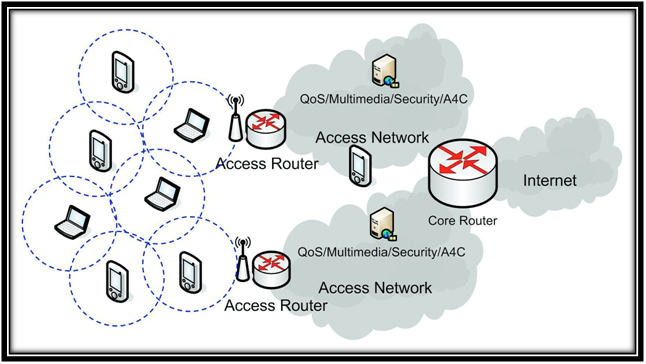NS2 Ad Hoc Projects
Guide to Implement NS2 Ad Hoc Network ProjectsAd Hoc Introduction:
An Ad hoc is an network which is composed of individual devices and has the ability to communicate with all other device directly.Ad Hoc implies spontaneous or impromptu construction. AD Hoc networks often bypass the gate keeping hardware or central access point such as a router for passing information.We have delivered more than 50+ Ad Hoc Projects using NS2 simulator.Reason to choose Ad Hoc Network Projects
- Ease of deployment.
- Speed of deployment.
- Decreased dependence on infrastructure.

Classifications of wireless adhoc networks:
- Mobile ad hoc networks (MANETs).
- Wireless mesh networks.
- Wireless sensor networks.
Advantages of Ad hoc network Projects:
- It can be more economical when compared to other network.
- Better mobility services.
- Ad-hoc networks posses extreme flexibility.
- Ad Hoc Network considered a robust network.
- Ad Hoc Network Possess non-hierarchical distributed control and management mechanisms.
Challenges on ad hoc networks:
- Packet losses.
- Battery power constraint.
- Device heterogeneity.
- Unstructured and/or time-varying network topology.
- Routes changes.
- Limited wireless range.
NS2 Projects Video Output
See our Latest Video Output of Ns2 Projects on Various Domain.
Ns2 Projects
Customized NS2 Projects for B.E/B.Tech/M.E/M.Tech/Ms/PhD Scholars.
Ns2 Projects Screen Shots
Ns2 Projects Screen Shots.Regular Update of NS2 Projects Screenshots here!
Sample code for NS2 Ad hoc network Projects:
This is the sample code for multicast routing protocol in NS2 ad hoc networks.
Routing protocol is CTR
set ns [new Simulator]
$ns multicast
set f [open out.tr w]
$ns trace-all $f
$ns namtrace-all [open out.nam w]
$ns color 1 red
# the nam colors for the prune packets
$ns color 30 purple
# the nam colors for the graft packets
$ns color 31 green
# allocate a multicast address;
set group [Node allocaddr]
# nod is the number of nodes
set nod 6
# create multicast capable nodes;
for {set i 1} {$i <= $nod} {incr i} {
set n($i) [$ns node]
}
#Create links between the nodes
$ns duplex-link $n(1) $n(2) 0.3Mb 10ms DropTail
$ns duplex-link $n(2) $n(3) 0.3Mb 10ms DropTail
$ns duplex-link $n(2) $n(4) 0.5Mb 10ms DropTail
$ns duplex-link $n(2) $n(5) 0.3Mb 10ms DropTail
$ns duplex-link $n(3) $n(4) 0.3Mb 10ms DropTail
$ns duplex-link $n(4) $n(5) 0.5Mb 10ms DropTail
$ns duplex-link $n(4) $n(6) 0.5Mb 10ms DropTail
$ns duplex-link $n(5) $n(6) 0.5Mb 10ms DropTail
# configure multicast protocol;
set mproto CtrMcast
# all nodes will contain multicast protocol agents;
set mrthandle [$ns mrtproto $mproto]
# set RV and bootstrap points
$mrthandle set_c_rp $n(5)
# $mrthandle set_c_bsr $n(1):0 $n(3):1
set udp1 [new Agent/UDP]
set udp2 [new Agent/UDP]
$ns attach-agent $n(1) $udp1
$ns attach-agent $n(2) $udp2
set src1 [new Application/Traffic/CBR]
$src1 attach-agent $udp1
$udp1 set dst_addr_ $group
$udp1 set dst_port_ 0
$src1 set random_ false
set src2 [new Application/Traffic/CBR]
$src2 attach-agent $udp2
$udp2 set dst_addr_ $group
$udp2 set dst_port_ 1
$src2 set random_ false
# create receiver agents
set rcvr [new Agent/LossMonitor]
# joining and leaving the group;
$ns at 0.6 "$n(3) join-group $rcvr $group"
$ns at 1.3 "$n(4) join-group $rcvr $group"
$ns at 1.6 "$n(5) join-group $rcvr $group"
$ns at 1.9 "$n(4) leave-group $rcvr $group"
$ns at 2.3 "$n(6) join-group $rcvr $group"
$ns at 3.5 "$n(3) leave-group $rcvr $group"
$ns at 0.4 "$src1 start"
$ns at 2.0 "$src2 start"
$ns at 4.0 "finish"
proc finish {} {
global ns
$ns flush-trace
exec nam out.nam &
exit 0
}
$ns run
Journal Support for Research Scholars

Ns2 Projects Work Progress
- MANET – Mobile Ad Hoc Network 95%
- VANET – Vechicle Ad Hoc Netwok 97%
- LTE – Long Term Evolution 78%
- IoT – Internet of Things 90%
- Wireless Sensor Network 89%
- Network Security 89%
- Ns2 Attacks 96%
- Cognitive Radio Network 85%
- Parallel and Distributed Computing 73%
- SDN – Software Defined Networking 95%
- P2P , Video Streaming , Peersim 96%
- IPV4 , IPV6 88%
- 4G Network , 5G Network 80%
- Visual , Underwater Sensor Network 79%
- Multicasting Communication 84%
- Wimax, WiFi 90%
- OFDMA 94%
Our Achievements – Ns2 Projects

